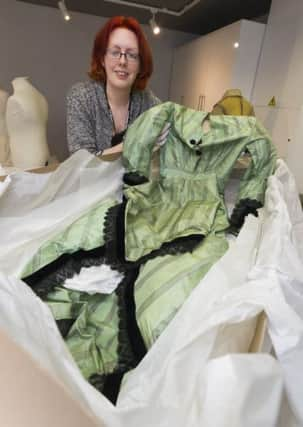Dress laced with arsenic features in bygone fashion exhibition in York


A 19th century dress which is laced with arsenic is going on show as part of an exhibition in York to showcase some of the more bizarre fashion statements from bygone eras - some with potentially lethal consequences.
The vibrant colour of the green gown is the cause of the wearer’s downfall. Part of the treatment process to produce its colour involved arsenic, and traces of the poison remain in the dress today – so curators wear gloves when handling it.
Advertisement
Hide AdAdvertisement
Hide Ad“On a dry fabric, this might not cause too many problems, but as soon as the wearer started to perspire, the arsenic could be absorbed into the blood stream – and as the arsenic absorbed replaces phosphorus in the bone, it would accumulate until it reached levels where it could cause illnesses from rashes and ulceration to dizziness, confusion and weakness of the hands and feet – permanent damage for which there is still no cure,” senior curator, Ali Bodley said.
Arsenic was not the only poison used in clothing production - mercury was commonly used in the production of felt for hats, and those who inhaled its vapours often suffered physical and neurological ailments including formication, the sensation of small insects crawling under the skin, insomnia, profuse sweating or increased salivation
“This was the origin of the phrase ‘mad as a hatter’ – and the Mad Hatter in Alice in Wonderland represented a person suffering from mercury poisoning,” said Ms Bodley.
“Ingredients that we now know to be toxic were regularly used during the dying of fabrics or in cosmetics applied directly to the skin, but often in relatively low concentrations during each wear or application, so it is not until much later that the devastating effects would have been experienced.”
Advertisement
Hide AdAdvertisement
Hide AdThe exhibition, Shaping the Body: Food, Fashion, and Life at York Castle Museum, also explores how diet and lifestyle has affected health and body shape over the last 400 years, from the once popular ‘TB chic’ of pale skin and protruding shoulder blades, to the obesity crises of the 19th and 21st centuries, and how Victorian fashions paved the way for 21st century body modifiers.
Displays feature a selection of rare and unusual corsets, including one that cinched the waist to an eye-watering 19 inches.
Ms Bodley said: “This wasp waist corset was probably worn by a young woman, and would have been reasonably comfortable, designed to be worn whilst playing tennis as well as resting – something that could not be said of the most extreme examples of corsetry which took waists down to 16 to 18 inches.
“These corsets were designed to accentuate the curves from bust to waist to hips, but the years of having such a narrow waist would have forced compression of internal organs – and it is little wonder that women would faint given the slightest excitement.”
Advertisement
Hide AdAdvertisement
Hide AdBut fashion was not restricted to women. Some of the most outlandish fashions 400 years ago were for men, who, inspired by the fashions of European royalty, used clothes as the ultimate status symbol of wealth.
“Gentlemen at the cutting edge of fashion would be wearing higher heels and frills on their clothes than some of the women,” said Ms Bodley. “These gentlemen were known as ‘Fops’, which was a derogatory term for someone overly – or foolishly - concerned with their appearance.”
Shaping the Body: Food, Fashion and Life opens at York Castle Museum on March 25.
Fad diets - not such a new idea
Fad diets and ‘miracle’ weight loss pills may seem like a modern phenomenon - but they were just as lethal in Victorian times as today.
Advertisement
Hide AdAdvertisement
Hide AdThe exhibition explores the effects of dieting and diet pills over the centuries. Victorian pills contained lethal ingredients such as arsenic, and in the 1930s there was a trend to deliberately infect yourself with parasitic worms to control weight.
Curator Ali Bodley said: “Of course, whilst some eras were marked by a trend to be skinny – including the early 19th century ‘TB chic’ where the gaunt, skinny appearance of someone suffering from consumption was considered attractive, to the 1990s equivalent of ‘heroin chic’, you also have periods when curvy figures were very much in vogue.
“As with today’s ‘Kardashian booty’, at the end of the 18th century, ladies would use padded ‘bums’ or ‘rumps’ to create an enviable round silhouette – more examples of history repeating.”